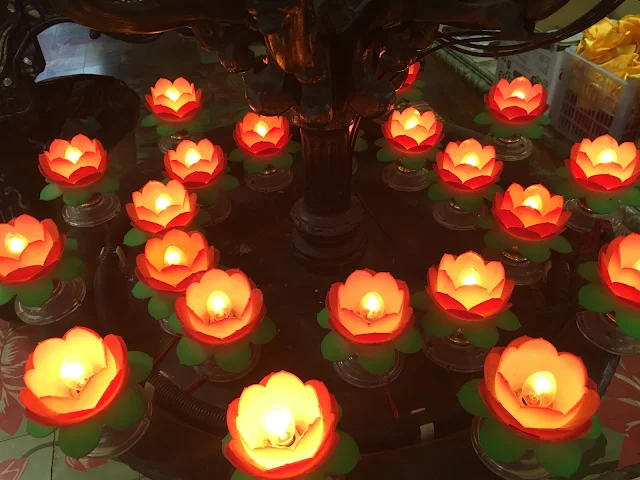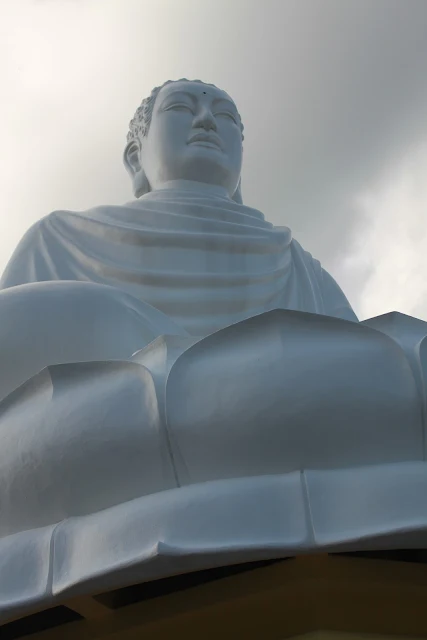The
Suoi Yen River is the path leading to the Perfumed Pagodas. Here, the manually paddled boat ride can take up to 90 minutes, indeed reminding me of how native Americans more than two centuries ago used to ride up the various waterways in the North American continent. Although the ride is calming and tranquil, it can be trying under a hot sun and humid conditions. The Perfumed Pagodas is a collective term for a concoction of variety in temples, walking trails, mountain scenery, interesting caverns and cable car journeys. This region lies just 65 kilometers south-west of Ha Noi. My Duc town is another popular set off point to this area, especially during the
Tet Festival or Lunar New Year period.
There are several major places of interest, but my sojourn there for just a full day had to be limited to a couple of pagodas - the
Thien Tru, also fondly known as the Heavenly Kitchen Pagoda (photo above) and the
Huong Tich, a revered grotto reached by a steep 120 step staircase. Both temple complexes are dedicated to the Buddha and the Goddess of Mercy,
Kuan Yin. They are sited in an area dotted with limestone cliffs, forested hills and fascinating caves. The area is known as the Perfumed Pagodas, in reverence to its Vietnamese language name of
Nui Huong Tich or the Fragrant Vestige Mountain. Previously this region was outside the shire of Ha Noi, but the boundaries have been redrawn in recent years to now include this fascinating area as part of greater Ha Noi.
The Heavenly Kitchen Pagoda complex was built in the 18th century AD and has three levels, including one with a triple-roofed bell pavilion and another with the main shrine. You can see the pavilion in the background of the picture above whilst the foreground is the foyer before the main shrine. before the third level is a tortoise pond (photo below).
The third level of the
Thien Tru Pagoda has embellished gold plated door and window frames. Other pagodas of note to visit are the
Den Trinh ( Registering Acceptance) and
Giai Oan (Undoing Injustice Pagoda).
To reach the
Huong Tich Pagoda, a visitor has two choices, walk all the way up terraced steps or opt for the Austrian built cable car system. a canine mate rests at the top station of the cable car route in the photo above, whilst one can find many vendor stalls selling food, handicraft and souvenirs if you walk all the way, up or down.
I found an antique sugar cane juice extraction machine (above) approaching the 120 step staircase to the cavern housing the
Houng Tich Pagoda. A phrase alluding to the Most Beautiful Cavern Under the Southern Sky is carved on the rocks near its entrance.
Going back to Ha Noi via another river ride in mid-afternoon, we are entertained in conversation by our guide (picture below) and then wait at a meet up point for our coach amidst padi fields. This excursion has provided us with insights into religion, rural life and geological formations not far from Vietnam's s capital city.
My group had lunch below the
Thien Thu Pagoda, very local food but delicious and in generous portions.
On the way back by road to Ha Noi, just before sunset, there was a commotion involving teenage school students, involving umbrellas, knives and women, which had temporarily blocked our path and when our coach could go through, we could see locks of hair lying on the tarred road.
Vietnam can be an enigma, but its reality can also be clear. It is a nation and economy in transition. It has eager minds, energy and hunger for a better life. Its people are reminded of the past but also embrace its unique heritage. Vietnamese can be practical and easy going but yet at other times, shrewd and careful. Education is so highly valued, together with family, prudence in savings and hard work. The country is rich in agriculture, cultural icons and increasing commerce. How can the nation fashion its future?



























































